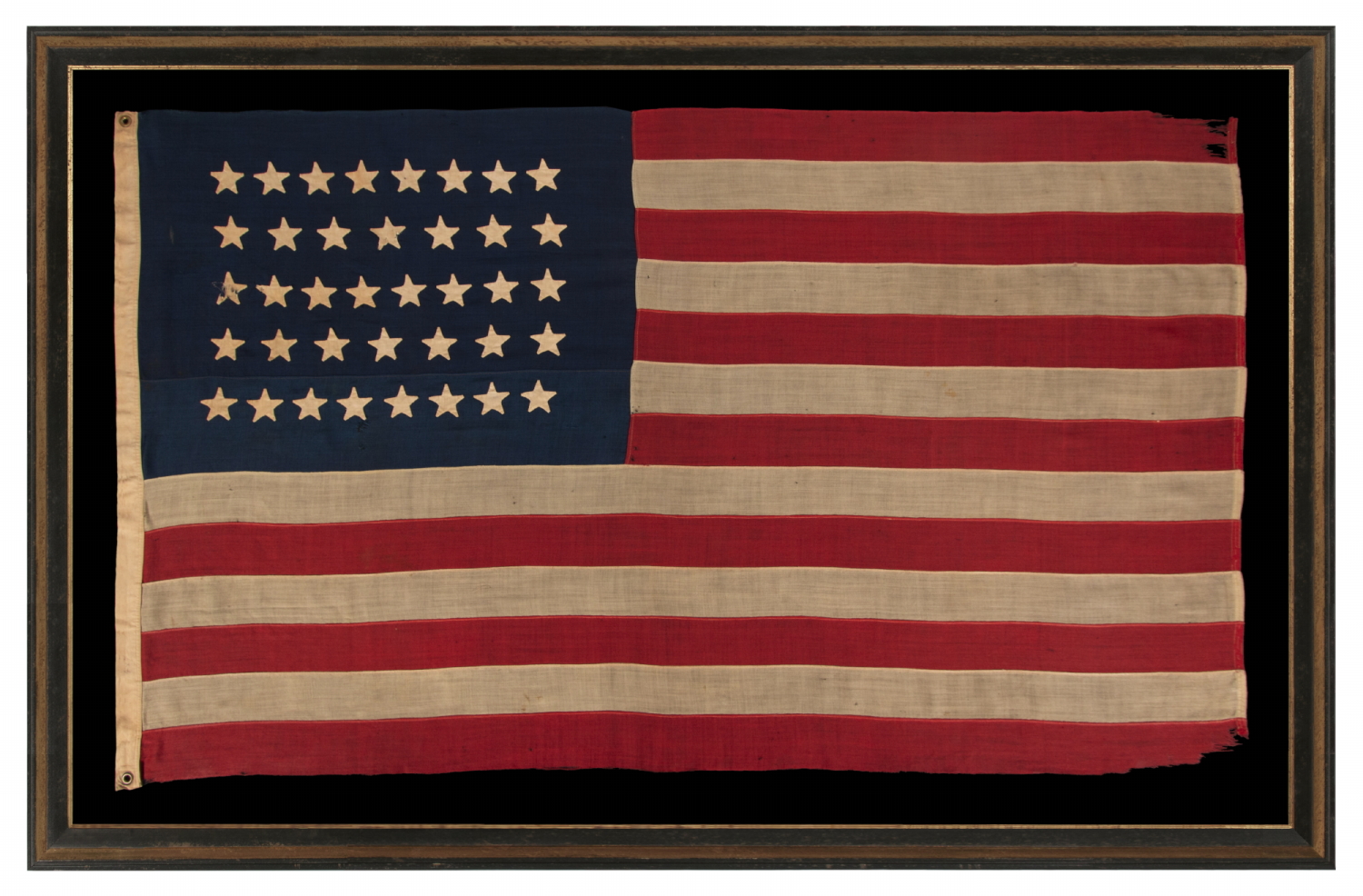
| |
38 STAR ANTIQUE AMERICAN FLAG WITH HAND-SEWN STARS IN AN 8-7-8-7-8 PATTERN OF JUSTIFIED ROWS, MADE IN THE PERIOD WHEN COLORADO WAS THE MOST RECENT STATE TO JOIN THE UNION, 1876-1889 |
|
| Available: |
Sold |
| Frame Size (H x L): |
Approx. 59.5" x 93.5" |
| Flag Size (H x L): |
47.5" x 81.25" |
|
| Description....: |
|
38 star American national flag, made in the period when Colorado was the most recent state to join the Union, with hand-sewn stars arranged in justified lineal rows in counts of 8-7-8-7-8. Oriented in an upright position throughout on their vertical axis (i.e., with one point up), the stars are made of cotton, hand-sewn, and double-appliquéd (applied to both sides) of the blue canton. The stripes and canton of the flag are made of wool bunting that has been pieced with treadle stitching, typical of the period. Because wool bunting was only available in a maximum width of eighteen inches, the canton is constructed from two lengths of blue fabric. Note how these differ just slightly in color, no doubt having come from two different dye lots. There is a twill cotton binding along the hoist, with two brass grommets. The colors are strong and the flag presents beautifully.
Colorado became the 38th state on August 1st, 1876. This was the year of our nation’s 100-year anniversary of independence. Per the Third Flag Act of 1818, stars were not officially added until the 4th of July following a state's addition. For this reason, 37 remained the official star count until July 4th, 1877. Flag-making was a competitive venture, however, and no one cared what was official. As soon as it was suspected that a new state was coming, stars were added by the makers of flags, both public and private. Some would have begun adding a star for the 38th state before it even entered the Union, in the early part of 1876. And almost none continued to produce 37 star flags, when their competitors were making 38’s. It is for this reason that flags with 38 and 13 stars, to reflect the original 13 colonies, are most frequently encountered at the Centennial International Exposition, the six-month long World’s Fair, held in Philadelphia, which served as the nucleus of the national celebration.
It is of interest to note that many makers of printed parade flags were actually producing 39 star examples in that same year, in hopeful anticipation of the addition of two more Western Territories instead of just one. The 39th state would not join the Union for another 13 years, however, when the Dakota Territory, entered as two states (numbers 39 and 40) on the same day, on November 2nd, 1889.
Mounting: The flag was mounted and framed within our own textile conservation department, led by expert staff. We take great care in the mounting and preservation of flags and have framed thousands of examples.
The background is 100% cotton twill, black in color, that has been washed and treated for colorfastness. The black-painted, hand-gilded and distressed molding is Italian. The glazing is U.V. protective acrylic (Plexiglas).
Condition: The flag was certainly flown, evidenced by the wear with associated loss in the upper and lower corners, at the fly end, where there is modest fabric loss. There is minor loss and fraying along the bottom edge of the flag, prior to this point. There is minor soiling along the hoist binding and in the starts, several of which have experienced fabric breakdown. The most significant of these incidences is present in the first star in the 3rd row. There are some extremely small spots of bleaching in the canton, and a couple of minor holes below the bottom row of stars, near the center of the canton. The flag presents beautifully because of the losses. Many of my clients prefer early flags to show their age and history of use. |
|
|
|
| Collector Level: |
Intermediate-Level Collectors and Special Gifts |
|
| Flag Type: |
|
|
| Star Count: |
38 |
|
| Earliest Date of Origin: |
1876 |
|
| Latest Date of Origin: |
1889 |
|
| State/Affiliation: |
Colorado |
|
| War Association: |
1866-1890 Indian Wars |
|
| Price: |
SOLD |
|
| |
Views: 853 |
|
|
|

